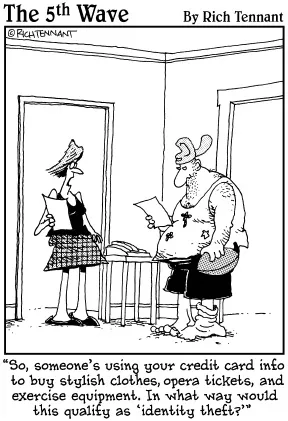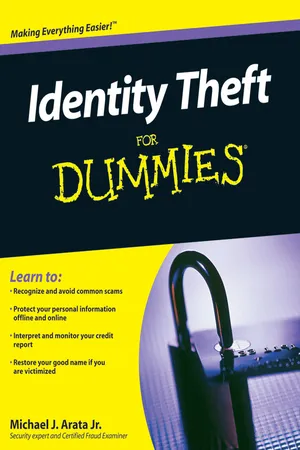Part I
Getting the Scoop on Identity Theft
In this part . . .
Identity theft is the fastest growing crime in recent years. To fight this crime, you need to know what it is and who it affects. You need to know what information is vulnerable and how to exercise prevention so that you don’t become a victim. I cover all this in Part I.
Chapter 1
Who’s Stealing What . . . and What You Can Do about It
In This Chapter
Understanding the scope of the identity theft problem
Knowing what information you need to guard
Using technology to help protect your information
Safeguarding your information every day
Finding help against identity theft
Fighting back if your identity is stolen
In this chapter, I explain who identity theft affects, how it happens, and what personal information it involves. Although identity theft is pretty unnerving, a greater understanding of it can be empowering. After you find out what identity theft is all about and how it occurs, you can protect your personal information from falling into the wrong hands — and you’ll know the best way to take action if it does.
Taking a Look at the Fastest Growing Crime
Identity theft happens when someone (the identity thief) uses another person’s personal information (such as name, Social Security Number, and date of birth) to fraudulently obtain credit cards or loans, open a checking account, or otherwise gain access to money or goods in the other person’s name.
Identity theft takes three primary forms: financial, criminal, and medical. Financial identity theft includes activities like credit card fraud, tax and mail fraud, passing bad checks, and so on. Of course, the identity thief’s objective is to not pay back any of the borrowed money but, instead, to enjoy spending it. Criminal identity theft is used to commit crimes in another person’s name and to finance criminal activities with the use of credit cards in someone else’s name, selling people’s identities, and even terrorism. Medical identity theft is when someone assumes your identity for medical reasons and/or for someone else to foot the bill.
In 2007, the U.S. Congress recognized the growth of identity theft and amended the Identity Theft and Assumption Deterrence Act (which was originally introduced in 1998), making identity theft a crime. In September 2003, the Federal Trade Commission (FTC) released the results of an impact survey that outlined the scope of the crime. The survey statistics show the following:
8.4 million Americans have been the victims of identity theft in 2007.
The total cost of this crime to financial institutions is $49.3 billion, and the direct cost to consumers is $5 billion.
The FTC noted identity theft as the fastest growing crime. The FTC will conduct an “Experiences of Identity Theft Victims” study with data from 2008. The FTC is also seeking comments on “Credit Freezes: Impact and Effectiveness in 2008.” The results will be available in 2010.
In 2007, identity theft led the list of top ten consumer complaints to the FTC.
Identity theft continues to be a concern for Americans, and it’s still the number one complaint filed with the FTC. If the economy continues on a downward trend, identity theft will continue to be an issue for those with good to excellent credit. The number of people with stellar credit is dwindling because of the recession the U.S. is currently experiencing. So if you have good to excellent credit, you need to be even more vigilant to prevent your identity from being stolen. Identity theft isn’t just using someone’s stolen credit card to make purchases, it is actually opening accounts in someone else’s name and using them. Stealing the credit card is fraud but does not entail assuming the cardholder’s identity. This distinction is important because when you report a stolen credit card, it isn’t classified as identity theft. Stolen credit cards are still an issue though, and you must protect your credit card(s). I discuss how to accomplish this task in Chapter 6.
Some other interesting stats from the FTC study that you may find surprising are
In more than 25 percent of all cases, the victim knows the thief.
In 35 percent of those cases, the thief is a family member or a relative.
Almost 50 percent of victims don’t know how their information was stolen.
The average out-of-pocket expense to individuals is $500.
So who exactly are the people who fall victim to identity thieves? Read the upcoming sections to find out the who and the how of identity theft.
Who identity theft affects
In addition to the statistics I note earlier, the FTC survey findings show that identity theft can happen to anyone with credit, bank accounts, a Social Security Number (SSN), a date of birth (DOB), or other personal identification information. That is, almost every man, woman, or child is a potential target. Yes, even children are susceptible to identity theft because all children have a SSN and all children have a DOB. Identity thieves don’t care about age; they just want personal information that they can use to obtain credit. The credit burea...


